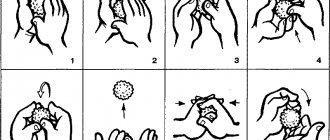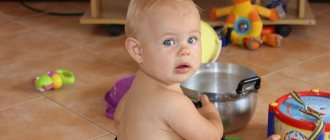How to teach a child to play independently? This question worries many parents. Partly because when the baby is busy with something of his own, mom and dad can devote this time to household chores, do some favorite activity, or just relax. And partly, parents understand that the development of a toddler’s ability to find an interesting activity for himself and the ability to do without adult care for some time is the next stage in the baby’s growing up. Another step towards his development as a person. There is no way to step over it. And how quickly a child learns a new skill directly depends on how much effort his family puts into it.
- 2 Playing space
- 3 What toys are best to offer?
- 4 Child 1-2 years old: where to start?
- 5 Games for children 3-4 years old
- 6 Video “How to get a child to play by himself?”
Why teach your baby to play independently?
Just as a baby cannot eat on his own or, for example, dress himself, he will also not be able to play alone until he is shown how to do it. Moreover, some time must pass for the baby to accumulate certain gaming experience.
A child should be taught to play in the same way as to walk, eat or dress independently.
Playing alone, the baby models life situations, looks for ways out of difficult situations, tries on different images, forms in his mind his own attitude towards good and evil, truth and untruth, etc.
Independent play develops in a child:
- a sense of self-confidence and strength;
- oral language and social skills;
- imagination and imaginative thinking;
- initiative and patience;
- perseverance and ability to overcome difficulties;
- skills in finding alternative solutions.
But all this is possible only on the condition that parents periodically direct the game in the right direction and provide the child with the correct (from the point of view of semantic content) and high-quality gaming equipment.
The toddler must first be taught to play different games, and then expect him to show initiative and some kind of passion for the gameplay.
You need to organize the play space for your baby so that he feels as comfortable as possible while playing.
One child can play from three months
Children can entertain themselves from the age of three months. First little by little, and then this time increases.
From three to seven months, a child can play alone for 5 to 10 minutes. He can be distracted by a mobile above the crib, toys with uneven surfaces: rustling, smooth, fur, velvety. Children can also be given teethers with different surfaces and soft books.
From eight months to two years, parents will have 10–20 free minutes. At 8-9 months, you can keep your baby busy with a mirror, and he will study himself. There is no need to be afraid: today they produce special safety mirrors for children. It is important for children to crawl, touch the floor, carpet, walls. This way they understand the materials better by touch and feel the difference between them.
From two years of age, a child is able to play on his own for 20-30 minutes, and from three years of age - 30-40 minutes or longer. The older, the longer the child entertains himself, if his parents taught him this and created the conditions. At any age, a child can play for one or an entire hour if he is interested.
At first, parents should come up with game options and play them with their children. Over time, the child will be able to do this without the help of adults.
Play space
To begin with, think about where and what the child will play with, so that you can safely leave him alone for a while. The baby should feel comfortable. And be completely safe at the same time.
Numerous prohibitions will prevent the toddler from being independent and active. Therefore, it is better to foresee all the dangers that may await the baby during play and eliminate them in advance.
Non-slippery floor, light stable chairs, low cabinets with children's things. Anything valuable, breakable and potentially dangerous for the baby should not be within his reach.
Give your child tasks with a specific result
Children love to imitate adults. And what could be more “adult” than an order for a specific job?
For example, you need to devote 45 minutes to cooking, and it is advisable that the baby does not distract you during this time (in this case, you dismiss the option of cartoons and games on the tablet). Give him cardboard, pencils and markers, stickers and ribbons and tell him that, for example, it’s your colleague’s birthday at work and you don’t have time to prepare a card for her. Could he help you out and make the card himself while you cook? You will be surprised how diligent children become when you manage to give them a specific goal. And yes, it’s better that the need for a card is real, otherwise you’ll end up with a lot of problems later with reporting on how much the birthday boy liked everything.
What toys are best to offer?
There should be few toys at the toddler’s disposal at any one time. Carry out regular inspections of your baby's household. Hide those in which your child’s interest has faded at the moment, and display those that he has already missed.
Thanks to this trick, you can always captivate your baby by placing a bag of forgotten toys in front of him. In addition, you won’t be able to buy new ones very often.
Toys for independent play
- Toy replicas of household items so that your child can imitate what adults do.
- Anything that will help the baby explore the world, explore the properties of, for example, water, sand, etc.
- Favorite toy friends (teddy bears-hares, dolls) with whom the little one sleeps, eats, and goes for walks. Which are perceived by the child as alive, and with whom he is never sad or bored.
- Secluded shelters (houses, tents, huts). They can be purchased, or you can build them yourself from scrap materials (stools, tables, pillows).
- Strollers, trolleys, radio-controlled or rope-powered cars.
- Sports toys: balls, dumbbells, hoops, jump ropes.
- Games that the baby already knows how to play well, but has not yet lost interest in them.
- A lot of things that are unnecessary, from your point of view (boxes, scraps, bolts, sticks, bags, chestnuts, pebbles, etc.).
Some toys are perceived by the baby as if they were alive; they become his friends, with whom he is not bored or scared. When teaching your little ones to play independently, you can, for starters, play out stories with them
It is better not to purchase interactive toys for independent play. They do not contribute to the development of the child’s imagination; they limit the flight of imagination to the framework of the written program.
And the baby must learn to find a toy in every object in his environment. For kids with good imagination, an empty box turns into a car, a sock into a snake, and daddy’s slipper into a brigantine.
The little one will appreciate bright and expressive toys that can be used for different games, without limiting the methods of use and without being tied to a specific plot.
A safe place to play and create
To play, the child must have a place where he is in charge. If not your own room, then a space with a table, chair, shelves for toys and upholstered furniture. At the same time, parents should tell the child that he can do creative tasks with paper, glue, and plasticine only at this table. This is how the child learns order.
An open shelving unit is suitable for storing toys - so that a child can easily take a car, doll or animal from the shelf and just as easily put it back.
- From 10 months, a child can be taught to order so that he takes them from the shelves and returns them to their place. First, you need to show him an example and do it together, and after a year the child will learn to put away the toys himself. If he forgets, you can remind him.
- A child needs five toys per year, and ten for two-year-olds and older. They can be changed: for example, leave ten in reach, and remove the rest. After a month, you can get out the hidden toys, and the child will enjoy them as if they were new. The main thing is not to touch the toys that the child constantly plays with, sleeps, or travels with - they should always be within sight. These toys calm the child: without them he will become anxious, have difficulty falling asleep, will look for them and cry.
- At two and a half to three years old, the child strives to dress himself, lace up his shoes, take dishes to the sink, and collect toys. Let him do this - then he will learn that no one will do something for him and that he can also play without adults.
At first, the child may spend more time on routine tasks that are easy for adults, so it is better to allocate additional time for the child’s activities: leave the house - start getting ready half an hour earlier than usual so that the child can dress and put on his shoes.
Ideally, a child should have the opportunity to do everything himself as much as possible. In order for him to turn on the light in the bathtub, the switch must be at eye level. So that you can sit on the toilet without the help of your parents, you can put a child’s stool: in Ikea, these cost 250 rubles, and parental time is priceless. You need to hang the hand towel lower so that the child can reach it. A hat, scarf, gloves and jacket too. Spoons and forks should be in a drawer from which the child can take them himself.
Games for children 3-4 years old
With the accumulation of gaming experience (and this is approximately by the age of three or four), the child is ready to move on to a new form of independent play - role-playing. At the same time, mom and dad can offer new stories and help the baby build more complex combinations.
What do preschoolers play?
- With dolls (to daughters and mothers, to family, to hospital, to store, to different professions).
- With cars (for cargo transportation, taxis, car dealerships, parking).
- With animals (to the farm, to the circus, to the zoo).
- With sports toys (relay races, tournaments, training).
- They play out the plots of their favorite fairy tales and cartoons.
- They love to play dress-up games.
Parents can be partners, advisers or outside observers, but the rules of the game should always be set by the child himself. There will be a time for playing by the rules
At this age, the main condition for relatives is not to impose their vision. At 3-4 years old there is no need to limit your child’s imagination. You can be a partner or an outside observer, an adviser. But the rules must be set by the child.
And remember, the more they play with the baby, the brighter his interest in games becomes, and the faster he begins to play on his own.
Create the right environment
Psychologist Margaret Paul says that the very first step to nurturing independence in a child is to create children's areas in the apartment, inside which children can behave as they want. Of course, these areas should be safe for the baby, located away from windows, heating systems, sharp corners and dangerous objects. It is not at all necessary to dedicate an entire room to your child - it could even be a corner in the kitchen or in your bedroom, but it should be full of multifunctional toys that are interesting for the child. The more uses a toy has, the better.
Video “How to get a child to play on his own?”
- Author: Polina
Hello. My name is Polina. Having once heard the truth that a pediatrician is the main doctor for any family with small children, I realized that I had something to strive for. Rate this article:
- 5
- 4
- 3
- 2
- 1
(1 vote, average: 5 out of 5)
Share with your friends!
Teaching a child to eat independently or preparing for kindergarten
How to teach a child to be independent?
If the child cannot play alone
It happens that a child clings to his parents and constantly asks for attention. If he is constantly naughty and asks his mother to stay nearby, you need to make sure that he does not want to eat, drink, sleep, or have his diaper changed. If basic needs are met and the child is healthy, he may have received too little attention.
Every day a child needs half an hour when mom or dad plays with him and is not distracted by anything else. It is better if the game takes place at the same time, for example after a nap. Children are calmer when they have a routine: they know what to expect and worry less. During this half hour, you can read a fairy tale, imagine together what else could happen to the characters, or take toys and put on a play with them based on an invented plot. And the child can draw and glue himself.
If after this the child clings to the parent, is capricious and does not want to play at all, this indicates anxiety. Perhaps the child asks for certainty, and he needs to say what will happen next: “Now we’ll draw with you, then I’ll go cook dinner, and you can play any game.” Perhaps the parents' behavior is causing anxiety. In this case, they need to see a psychotherapist.
Happinnes exists
Happiness can be different, sometimes it is a delicious dinner in a warm company, and sometimes it is your own apartment, to which it is pleasant to invite guests.
If you want one, come to the Airplane. Look at this happiness
Bring order to everything that surrounds your child at home
I had adhered to Montessori principles before, but we didn’t have any orderliness. During the training I realized how significant this is for a child. To teach him to play independently, it is necessary to structure the home space. Then it will be easier to trust the environment, and he will become calmer and more confident. Knowing where and what is and why it is needed, even a restless person will be able to occupy himself and develop with pleasure.
We arranged the hallway so that it would be convenient for Manuela to get and put on her things:
The bathroom and kitchen were changed using the same principle:
When the kitchen was remodeled, Manuela began to work more on it, now she feels that this is her personal space and monitors the cleanliness. Now it’s easy for her to cook for herself. As a bonus, fine motor skills develop during this activity.
Re-sorted clothes. The child gives a surprise before bed every evening - he folds all his things and puts them back in their place.And here is our creativity zone:
Free lessons from experts
They will help you take the first steps in developing independence in your child.
Rethink the role of a parent
Already in the first lessons, my husband and I heard many important things that changed our minds about parenthood. And as soon as they began to put the teachers’ recommendations into practice, my daughter also changed: for example, she became less capricious and now makes decisions herself, and then carries them out.
We realized that if we want to teach a child independence and lay in him the foundations of a harmonious personality, we need to start with ourselves. The child “mirrors” us, which means that first of all you need to put your life and relationships with others in order.
Here are some more important principles:
- The child should be treated as an individual, given the right to make decisions within the framework of the overall family strategy.
- It is necessary to prepare the home space so that the child can gain rich sensory experience in it and become more independent every day.
- It is important not to miss windows of opportunity at each stage of a child’s development, but to use them as productively as possible.
- You need to be careful when communicating with your child and take care of yourself.
- The parent’s task is to give the child the opportunity to move at his own pace, choose his own activities and maintain independence.
- The foundation for positive socialization is laid in childhood.
- It is important to develop internal discipline in a child.
- We must not forget to include the child in the life of the family and take care of the environment together, draw his attention to the beauty of the real world.
I began to understand myself and others more, I see the consequences of missed opportunities. Once again I was convinced that there are no bad children. Very, very much depends on the parent and his approach to the upbringing and development of the child.
After this lesson, I wanted to become even better, to do everything possible so that my daughter had a happy childhood, filled with discoveries and the joy of family relationships.
The importance of independent games
A loving parent always feels remorse when a child asks for attention, but there is no time to play with him. The dishes won’t wash themselves, the food won’t cook, and there’s also cleaning and a list of other things to do. If the baby does not know how to occupy himself, even ordinary cleaning turns into a nightmare. Screaming, endless running, throwing things around not only interfere with getting work done, but also fray the nerves of all family members.
There is only one way out of the situation - to teach the child independence. Starting from the age of 1, the baby stops perceiving the world around him through his parents. It is natural for him to explore everything alone. Mom and dad are assistants who can do what he cannot yet do, guide, teach.
Independence is an integral part of growing up. It makes a person mature, capable of decisions and actions. Independent children are better socialized. In adult life, they are more successful, make a dizzying career, achieve their goals, and do not break down under the weight of problems.
Choosing the “right” clothes
To help your child, you should pay attention every time to the presence of buttons, buttons, and zippers on children's clothing. It should be convenient for the child to fasten and unfasten so that he does not lose interest in it.
Velcro on shoes and clothing should be wide, and the tape should stick easily. The buttons should click easily. Usually new buttons are tight, parents should work them out a little so that the child does not suffer with them.
Choose clothes with round buttons; buttons in the shape of animal figures or flowers are beautiful, but sometimes they are very difficult to unfasten. Check how well all the buttons fit into the buttonhole. The size of the buttons should correspond to the child’s fingers; he should easily grasp them with two fingers.
The zipper should not jam, the lock should be as large as possible so that a child can easily get into it.
It is better to choose shoelaces with strong metal or plastic tips. The ends of the laces should be small.
Books for children under one year old
Starting from 6 months, you can start introducing your baby to the first books!
It is better if these are small books made of thick paper/cardboard with bright, large pictures (as natural as possible) and short poems (Barto, Marshak, Chukovsky). Folk tales are also suitable.
As the year approaches, you can start studying using educational books for babies. Nowadays there is a large number of different developmental aids on the market. For kids, for example, options such as Baby's First Book (Dragonfly), My First Book (White City), Yearly Course of Lessons (Exmo), Speech Development Album (Rosman), Smart Books (Swallowtail), My First Stickers ( Dragonfly), Logic (Eksmo) and many others. A very large selection of books at affordable prices can be found in Auchan hypermarkets.
At the age of about one year, children move to a new stage of their development, begin to walk and explore the world around them even more actively. However, psychologically a child cannot always cope with a large number of new skills and impressions. This can affect his behavior, the baby begins to be capricious, irritated, behave contradictory, and disobey his parents. Many experts associate this age with the period of the first crisis.
Introduce your child to developmental activities based on their needs
During the training we understood several important points:
- A child should not be surrounded by random objects and circumstances: everything that is in his environment must have a purpose.
- One material should be aimed at developing one sense organ.
- All materials should look aesthetically pleasing, attracting the child.
The course brought into our lives many interesting and useful activities aimed at recognizing tastes and smells and working with colors:
It is important that the child can interact with the material. For example, we conducted two experiments with magnets. My daughter was delighted and discovered for herself that objects can cling to each other! I found door locks that also have a magnet attached to them.
Together we explore the beautiful world, put together luminous puzzles of the solar system and say that there is a sun, planets, and satellites. Let's get acquainted with the world around us.
Manuela draws a lot and reads on her own:
How long can a child be left to his own devices?
All children are different. Some people can play the same game for hours, others can’t sit still for 5 minutes. Time for independent play is individual. If the baby is perfectly occupied with himself, there is no need to interfere. It’s better to pay attention to him later, devoting 20-30 minutes of time to playing together. Psychologists believe that for 80% of children this minimum is enough not to feel deprived or abandoned.
In a situation where a child absolutely does not want to play on his own, you need to start small. First 5 minutes, then 7, 8 and so on. The only thing that needs to be taken into account is the baby’s ability to concentrate. Children cannot indulge in one activity for too long. According to the norms, a child of 2 years old can be completely captivated by something for 4-10 minutes, at 3 years old - 6-15 minutes, at 4 years old - 8-20 minutes. Further, concentration decreases, and rest or a change of activity is necessary.
A 2-4 year old child gets tired of the monotonous game after an average of 10 minutes. To prevent him from getting bored, it is worth offering him different activities, alternating outdoor games with educational ones. You can dilute the games by watching cartoons.
Examples of independent games
The more games a parent can offer a child, the higher the likelihood that he will become interested in something and do it on his own. You need to have at least a dozen different options in your arsenal.
Here are some examples of games.
- Draw. The child is given the task of drawing a postcard for his grandmother or mother. To increase interest, you can invite him to use stencils, felt-tip pens, gel pens with glitter, and stamps.
- Build a house for dolls or a garage for cars. An almost win-win option is to ask the baby to prepare a place for further play with an adult. He must build, for example, a garage from a block constructor. When he finishes everything, mom will join the game.
- Who is faster? Children 2-4 years old love to win in competitions. You can invite your child to do something at speed. For example, a mother washes the dishes and a child puts away toys. Or the mother is preparing soup, the child is putting together a puzzle.
- Fill in the blanks. An adult cuts out a heart, house, dog, car or any other shape from colored paper. Then he makes spaces in the middle. For the first time, you can cut out 3 squares. The figure is pasted onto a white sheet, the squares are placed next to each other. The child must put them in their place. Later, the game becomes more complicated with a large number of spaces and their different shapes.
Selection of toys
Choosing the right toys is the first step to success. It is important that the child can show imagination, for example, build, draw, or sculpt something. This will also allow you to enjoy and show off the fruits of your labors.
Toys that are suitable for independent play for children aged 2-4 years:
- puzzles;
- designers;
- bodyboard;
- coloring books and applications with stickers;
- supplies for drawing, crafts made from plasticine or paper;
- kinetic sand;
- mosaic;
- figurines of heroes;
- accessories for role-playing games (doctor, builder, hairdresser);
- doll house, railway, parking lots.
Girls like to cook in toy dishes, imitating their mother, boys like to fix something, like dad. Toys that seem simple at first glance captivate children much more than modern talking dolls and robots.
A child should not have too many toys, at least not in sight. The larger the assortment, the more difficult it is for the child to decide what he wants to play. It is optimal to leave 5-7 different items on the shelf and hide the rest.











